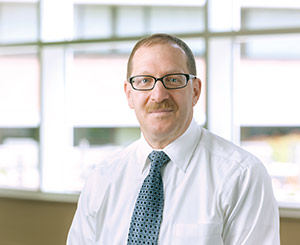April 5, 2016:
While advocating for the creation of Philadelphia’s first firefighting organization, Benjamin Franklin offered his now famous advice: “an ounce of prevention is worth a pound of cure.” That adage continues to resonate with us as the fires of cancer continue ravaging the nation nearly 280 years later posing as the second leading cause of death.
In his proclamation for National Cancer Control Month this year, President Obama encouraged citizens, government agencies, businesses, nonprofit organizations, and other groups to join together in efforts to “increase awareness of what Americans can do to prevent and control cancer.”
Read on to learn what a few of the Big Ten Cancer Research Consortium members are doing surrounding these two important awareness topics: cancer prevention and health equity.
A Life-Saving Routine

Duane Johnson with wife, Clara
It started on the first anniversary of 9/11. Duane Johnson, a retired schoolteacher, wanted to make a difference. He stopped by a local American Red Cross blood drive and rolled up his sleeves. From there on out, it became a regular routine for the next 12 years.
But as it ends up, giving blood may have helped save Johnson’s life.
In 2014, during a routine visit to the Red Cross, Johnson left a bit concerned.
“They told me my iron count was low, which had never happened before,” explains Johnson. “A couple months later, same problem. They told me to go home, eat some spinach and steak and come back. But, when I did, the same thing happened.”
Johnson, who was a firm believer in keeping up with his screenings and annual exams, grew more concerned. Cancer was common in his family — his father’s mother, father’s two brothers and two sisters all had cancer. This inspired him to become more vigilant about his own health and screenings.
Johnson was due for an annual exam so he scheduled an appointment with his primary care physician at Nebraska Medicine, Dennis Goeschel, MD.

Gary Volentine, MD
It was April 2014. Dr. Goeschel ran a series of tests, which came back inconclusive. Although Johnson wasn’t due for another colonoscopy for another three years, Dr. Goeschel suggested he get one on the calendar soon. Five days later, Johnson received a shocking call from his gastroenterologist, Gary Volentine, MD.
“Duane is a lucky man,” says Dr. Volentine. “During the colonoscopy, I looked in his stomach, colon and small bowel and didn’t see anything.” But Dr. Volentine had a hunch. He decided to take his scope up to the distal small bowel, a more difficult area to reach and not typically done during a colonoscopy. “It’s unusual to find anything there, but I saw something that looked like a small ulcer and I got a biopsy.”
Dr. Volentine’s hunch turned out to be lymphoma, explaining Johnson’s anemia.

Philip Bierman, MD
Johnson was immediately referred to Nebraska Medicine oncologist/hematologist Philip Bierman, MD. The finding surprised both Dr. Volentine and Dr. Bierman.
“Lymphoma is very uncommon to find during a colonoscopy,” explains Dr. Bierman. “Typically, when we perform a colonoscopy, we’re looking for the more common types of colon cancer. Lymphoma would be an unexpected finding.”
“It just goes to show you how important it is to follow through with recommended screenings like colonoscopy,” says Dr. Volentine. “And when your doctor tells you to get a test or screening, you need to do it. In Duane’s case, it may have saved his life.”
Reducing nicotine levels in cigarettes may help reduce smoking and save lives
In the mid-1990s, University of Minnesota graduate Jack Henningfield, PhD, and a colleague published an article in the New England Journal of Medicine theorizing that if nicotine levels in cigarettes were reduced below a certain threshold, they would no longer be addicting. It was an intriguing premise — but largely unproven and unlikely to be tested by the companies that made cigarettes.
In 2009, however, Congress passed the Tobacco Control Act, giving the U.S. Food and Drug Administration the authority to regulate tobacco products, including the amount of nicotine in cigarettes.
Around the same time, Masonic Cancer Center member and tobacco researcher Dorothy Hatsukami, PhD, a professor of psychiatry at the U, convened a meeting of tobacco control researchers, policymakers, and government agencies to assess the feasibility of reducing nicotine in cigarettes as a national policy measure.
While the science supported such an approach based on results from prior studies conducted by Hatsukami and others, more research was needed. Would lowering the amount of nicotine reduce addiction? And what reduction was required to do so?
“If you reduce dependence on cigarettes, then you are likely to reduce the number of people who smoke,” says Hatsukami, who holds the Forster Family Chair in Cancer Prevention.
Read more about Hatsukami’s important work
National Minority Cancer Awareness Week (April 10 −16)
According to the American Cancer Society, “cancer affects different populations differently, and minority groups in the United States continue to bear a greater cancer burden than whites. Much of this difference is due to factors like poverty and lack of access to prevention/detection services and high-quality treatment, according to reports produced by the American Cancer Society. For instance, African Americans and Hispanics in the US have higher poverty rates than whites and are less likely to have health insurance, making it harder for them to get the care they need.”
Differences in Type of Small Protein May Further Elucidate Lung Cancer Risk in African Americans

Sharon R. Pine, PhD
Research from an investigator at Rutgers Cancer Institute of New Jersey and colleagues from the National Cancer Institute (NCI) and other facilities, shows differences in a certain type of small protein vary by race and may contribute differently to the development of lung cancer in African Americans and European Americans. Rutgers Cancer Institute of New Jersey researcher Sharon R. Pine, PhD, assistant professor of medicine at Rutgers Robert Wood Johnson Medical School, is the co-lead author of the work published in the March 4 issue of Cancer Epidemiology, Biomarkers & Prevention. She shares more about the work.
Q: Why is this topic important to explore?
A: Lung cancer is the leading cause of cancer deaths in the United States and has a poor five-year survival rate of only 16 percent. This in part can be attributed to the disease being diagnosed at a later stage. Identifying biomarkers of lung cancer may improve early detection and ultimately increase survival. African Americans have a higher chance of developing lung cancer and have lower lung cancer survival rates as compared to European Americans, which research shows may be due to differences in genetics, environment or modalities of care. Identification of biomarkers that would uniquely distinguish African Americans at a high risk of lung cancer may help to bridge the gap in lung cancer racial health disparities. Our work involves cytokines, which are small proteins released by cells that affect communication between cells. Our team hypothesized that a difference in serum cytokine levels between the two populations may yield some answers.
Q: What did you and your colleagues find?
A: We analyzed the levels of ten serum cytokines in blood samples from over 450 African-American and European-American lung cancer patients or healthy adults. We found the levels of six cytokines were significantly higher among European Americans than African Americans. The levels of two cytokines were associated with lung cancer in both races, but other elevated cytokine levels were associated with lung cancer only in African Americans. We then verified our findings by testing patients enrolled in the prospective Prostate, Lung, Colorectal, and Ovarian Cancer Screening Trial and the Wayne State University-Karmanos Cancer Institute case-control study.
Q: What is the implication of these findings?
A: These findings suggest that cytokine levels in the blood vary by race and may contribute to lung cancer differently between African Americans and European Americans. Additional work would be needed to confirm our results, but our data suggest that testing for these cytokines could help identify African Americans who are at an increased risk of developing lung cancer, and thus, potentially improve survival for lung cancer patients.
University of Minnesota is taking action to promote health equity
The University of Minnesota will be sponsoring a conference on health equity May 5-7. This will be an action oriented conference focused on building and showcasing partnerships, research, programs, and policies to promote health equity across the region.
Who should participate: Community organizations, community members, public health and health care practitioners, and researchers seeking to build solutions to health inequities through partnership.
Objectives: At the end of the conference, participants will be able to:
1 Engage: Recognize how partnerships among community, practitioners, and researchers build solutions to pressing community health priorities. Identify opportunities for new partnerships and describe collaborative processes that create and sustain partnerships.
2 Inform: Identify research and community generated strategies to increase health equity through programs and interventions, including those addressing social determinants of health.
3 Act: Recognize steps partnerships take to successfully move from research to action in addressing health inequities through programs, advocacy, and policies.
You Can Join the Fight Against Cancer
![]() Did you know you can directly support the team efforts of the Big Ten Cancer Research Consortium? Make a gift today!
Did you know you can directly support the team efforts of the Big Ten Cancer Research Consortium? Make a gift today!
This story was compiled by Alecia Burkhardt, communications associate for the Big Ten Cancer Research Consortium, with contributions from the University of Minnesota Masonic Cancer Center, Fred and Pamela Buffett Cancer Center, and Rutgers Cancer Institute of New Jersey.
About the Big Ten Cancer Research Consortium: The Big Ten Cancer Research Consortium was created in 2013 to transform the conduct of cancer research through collaborative, hypothesis-driven, highly translational oncology trials that leverage the scientific and clinical expertise of Big Ten universities. The goal of the Big Ten Cancer Research Consortium is to create a unique team-research culture to drive science rapidly from ideas to new approaches to cancer treatment. Within this innovative environment, today’s research leaders collaborate with and mentor the research leaders of tomorrow with the unified goal of improving the lives of all patients with cancer.
About the Big Ten Conference: The Big Ten Conference is an association of world-class universities whose member institutions share a common mission of research, graduate, professional and undergraduate teaching and public service. Founded in 1896, the Big Ten has sustained a comprehensive set of shared practices and policies that enforce the priority of academics in the lives of students competing in intercollegiate athletics and emphasize the values of integrity, fairness and competitiveness. The broad-based programs of the 14 Big Ten institutions will provide over $200 million in direct financial support to almost 9,500 students for more than 11,000 participation opportunities on 350 teams in 42 different sports. The Big Ten sponsors 28 official conference sports, 14 for men and 14 for women, including the addition of men’s ice hockey and men’s and women’s lacrosse since 2013. For more information, visit www.bigten.org.














Subscribe to the Big Ten CRC Newsletter X
X Facebook
Facebook YouTube
YouTube